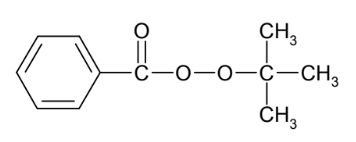Enhanced TDS
Identification & Functionality
- Chemical Family
- Chemical Name
- Manufactured By
- Plastics & Elastomers Functions
- Technologies
- Product Families
- Chemical Structure

Features & Benefits
- Materials Features
Applications & Uses
- Compatible Polymers & Resins
- Application Information
- Trigonox C is used for the crosslinking of natural and synthetic rubbers, as well as thermoplastic polyolefins.
- Rubber compounds containing Trigonox C have moderate processing safety in combination with a very high rate of cure.
- Safe processing temperature (rheometer ts2 > 20 minutes): 100°C
- Typical crosslink temperature (rheometer t90 about 12 minutes): 140°C
- Trigonox C is not recommended for compounds which contain carbon black.
Properties
- Physical Form
- Appearance
- Clear liquid
- SDS Physical and Chemical Properties
Value Units Test Method / Conditions Oxidising Properties Not classified as oxidising - - Appearance Colorless liquid - - Organic Peroxides 98 % - Active Oxygen Content 8 % - Explosive Properties Not Explosive - - Kinematic Viscosity (at 20°C) 5.77 mm²/s - Dynamic Viscosity (at 20°C) 6 mPa.s - Self-Accelerating Decomposition Temperature 60 °C SADT Decomposition Temperature Decomposition may occur below the SADT - - Immiscible in (at 20°C) Water - - Partition Coefficient (at 25°C, log Pow) 3 - - Relative Density (at 20°C) 1.04 - - Vapor Pressure (at 50°C) 0.4 hPa - Flammability (Liquids) Decomposition products may be flammable. - - Flash Point min. 60 - - Boiling Point Decomposes below the boiling point - - Melting Point 9 - 11 °C - Soluble in Organic solvents - - pH Value Neutral - - - Characteristics
Value Units Test Method / Conditions Self-Accelerating Decomposition Temperature 60 °C - Storage Temperature 10 - 25 °C - Crystallization Point (tends to undercooling) 8 °C - Viscosity (at 20°C) 6.5 mPa.s - Density (at 20°C) 1.04 g/cc - - Specifications
Value Units Test Method / Conditions Active Oxygen Peroxide Content 8.24 % - Active Oxygen Content min. 8.07 % - Inorganic + Organic Hydrolysable Chloride max. 50 mg/kg - Hydroperoxides (as Tert-Butyl Hydroperoxide) max. 0.10 % - Assay Content min. 98.0 % - Color max. 100 - Pt-Co / APHA Molecular Weight 194.2 - -
Regulatory & Compliance
Technical Details & Test Data
- Thermal stability
- Organic peroxides are thermally unstable substances, which may undergo self-accelerating decomposition. The lowest temperature at which self- accelerating decomposition of a substance in the original packaging may occur is the Self-Accelerating Decomposition Temperature (SADT). The SADT is determined on the basis of the Heat Accumulation Storage Test.
- For Trigonox C SADT : 60°C (140°F)
Packaging & Availability
- Country Availability
- Packaging Information
- In North America Trigonox C is packed in non-returnable, one gallon polyethylene containers of 8 lb net weight (packed 4 per case) and 5 gallon polyethylene containers of 40 lb net weight.
- In other regions the standard packaging is a 30-liter HDPE can (Nourytainer®) for 25 kg peroxide.
- Both packaging and transport meet the international regulations. For the availability of other packed quantities contact your AkzoNobel representative.
- Trigonox C is classified as Organic peroxide type C; liquid; Division 5.2; UN 3103.
Storage & Handling
- Storage Information
- Due to the relatively unstable nature of organic peroxides a loss of quality can be detected over a period of time. To minimize the loss of quality, AkzoNobel recommends a maximum storage temperature (Ts max.) for each organic peroxide product.
- Ts max. = 25°C (77°F) and
Ts min. = 10°C (50°F) to prevent crystallization
